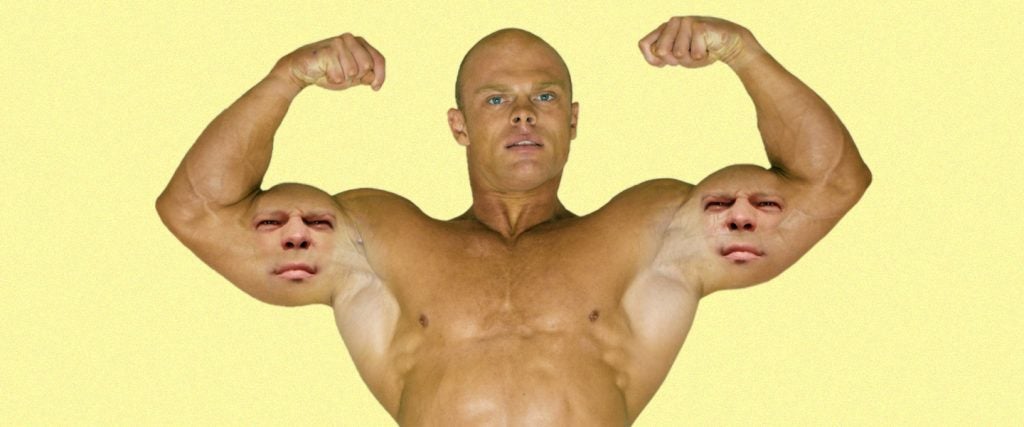You’re absentmindedly struggling through your tricep kickbacks when you happen to overhear a personal trainer at your gym chastising a client about how their antagonist muscles were too involved in their last lift. “Antagonists?” you think to yourself. “I didn’t know my muscles could be antagonists! I thought they were on my side!”
But there’s no need to eye your own muscles with suspicion, awaiting the moment when they’ll turn against you on a chilly March morning and leave you gasping on the floor like Julius Caesar, in a bloody heap of betrayal. When it comes to fitness, the word “antagonist” has a very precise meaning.
So what exactly is an antagonist muscle?
The word “antagonist” is a derivative of the Greek word antagonistēs, which translates into some form of opponent or competitor, and which stems from a combination of the words anti- (“against”) and agonizesthai (“to contend for a prize”). So when you take origins into account, you’d be correct to suspect that an antagonist muscle is something to fight against.
The truth, however, is far different.
This is why it’s also helpful to know what an agonist is. The word agonist is a derivative of the Greek word agōnistēs, which is a combatant or a champion. With this in mind, you can put both the work of the exercise and the postures of the involved muscle groups into their proper focus. Still, you need to be careful about the application of the terms. If you think of the agonist muscle as your champion that’s actively agonizing against the weight, you could logically deduce that the antagonist muscle might be the muscle opposing it in a literal sense, fighting against it with the same ferocity Shredder might employ to fight a Ninja Turtle.
In reality, the antagonist muscle refers to the muscle that opposes the agonist muscle in a positional sense. The agonist muscle is the prime mover during an exercise, and the antagonist muscles are the muscles situated on the opposite side of the agonist muscles. Sometimes, the antagonist muscle provides opposing force to counter the movement of the agonist muscle. Other times, it relaxes and lengthens as the agonist muscle performs its work.
Again, the antagonist is the opposite of the agonist in this scenario, not an antagonist in the way we typically understand it. There is no intramuscular Lex Luthor to offset Superman in this analogy.
Can you give me some examples of this?
Nothing easier.
Muscles are often arranged in antagonistic pairs, meaning that they swap roles depending on which muscle group is performing the work. The bicep and tricep muscles share the same joint attachments — both groups tie into the shoulder joint and the elbow joint. When your biceps execute curls, they’re the agonist, and your triceps assume the antagonistic role. When you lie down and do skull crushers after you’ve finished with your chest workout, your triceps become the agonist, and your biceps become the antagonists.
Similarly, whenever you extend your knees, your quadriceps are acting as the agonists, and your hamstrings act as antagonists. When you perform hamstring curls, the roles reverse. Because the arms and legs both have hinge joints — the elbows and knees respectively — the antagonistic pairs are easy to spot.
However, even when muscles don’t share the same joints as obviously, it’s still easy to spot the agonist and antagonist in each relationship if you can recognize the direction in which the work is being executed and the muscles performing it. The back and chest muscles often rotate the agonist and antagonist roles when you perform pull-ups and push-ups, or any other pulling and pressing motions.
Does this mean I should train the agonist and antagonist muscles together?
Should you? If you’re careful, it can’t necessarily hurt. Plenty of people have arm day and leg day at the gym. On arm day, they’ll train biceps and triceps (and often forearms), and on leg day, they’ll train quadriceps and hamstrings at the same time they train glutes and calves. In reality, the majority of the experienced lifters I know who opt to train muscle groups together usually pair chest and tricep training, and also back and bicep training, because those are the small muscles that are heavily taxed during the training of those large muscles.
Also, if I’m being honest, I can’t say that I know a single person who routinely trains back and chest on the same day, except for a couple of guys who train with kettlebells, and those lunatics train their entire bodies every time they exercise. I know that no less an authority than Arnold Schwarzenegger regularly trained chest and back on the same day, but anytime I even consider doing something that Arnold once did, that’s usually the very same instant I remind myself that Arnold was an avid user of steroids, and anything a known steroid user does should be questioned before its replicated. People who aren’t taking steroids typically can’t do what steroid users can do at the same volume, with the same regularity or with the same results, while also remaining injury-free.
All of which is to say, train your muscles in the manner you’re most comfortable with, but don’t lump them together into the same training program simply because it was the suggestion of the guy at the club who’s built like the greatest antagonist of them all.


